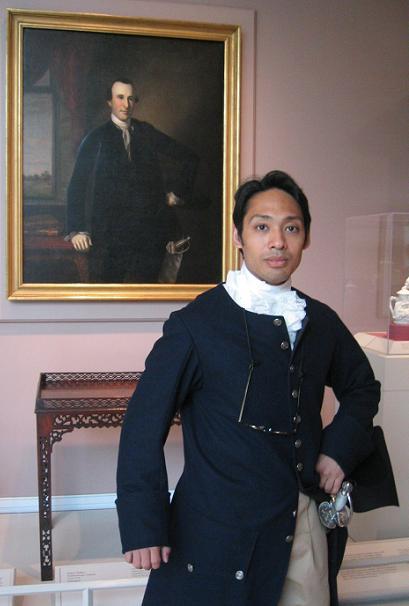Subject: militia officer
Culture: Colonial-Revolutionary American
Setting: French & Indian War, American Revolution, North America 1754-1783
Context
*
Costume
* Baumgarten 1986 p52, 62
"By 1700 men's suits had assumed the three-piece format still worn in the twentieth century, although the components certainly differed in appearance from today's vested suit. Eighteenth-century suits had long coats, waistcoats that corresponded to the vest and were worn beneath the coat, and knee-length breeches buttoned at the center front. The three parts of the suit, the cut and style of which evolved during the eighteenth century, were not necessarily made of matching colors or fabric." [...]
Accessories
* Baumgarten 1986 p71
Pistol
* Neumann 1954 p150
"Most accounts of our Revolutionary War weapons give little attention to the pistol -- probably because it was decidedly inaccurate except at close range, and not included in most battlefield tactics. Yet, the handgun did see considerable service as a personal weapon. It was considered normal for civilians to carry pocket pistols for protection while traveling. Among military personnel, officers, mounted troops, and seamen used them as standard arms."
Swords (Baskethilt, Hanger, Saber, Smallsword)
* Neumann 1954 p216
"Prior to the Revolutionary War, the Americans obtained most of their blades in Europe. Those used during the conflict came largely from existing civilian swords, colonial arsenals (left from the French and Indian Wars), local manufacture, and imports. Existing specimens indicate that blacksmiths produced many crude yet serviceable swords, while a great variety of hilts were added to standard European blades. Some American craftsmen did produce silver-hilted and other fine-quality swords, but they were limited to a small number."
Polearms
* Neumann 1954 p328
Although the long infantry pike officially ceased as the basic weapon of war about 1700, polearms persisted in limited use until the nineteenth century. During the colonial and American Revolutionary War era, they served mostly as symbols of rank."
Guns
* Neumann 1954 p32
"The principal weapon of the eighteenth century was the flintlock shoulder arm. Basic types believed to have been used in America from 1700 to 1783 .... They are grouped into five general categories:
1. MIlitary Muskets
2. Carbines
3. Fusils
4. Blunderbusses
5. Wall or Rampart Guns"
